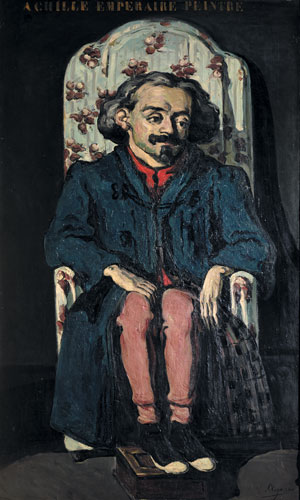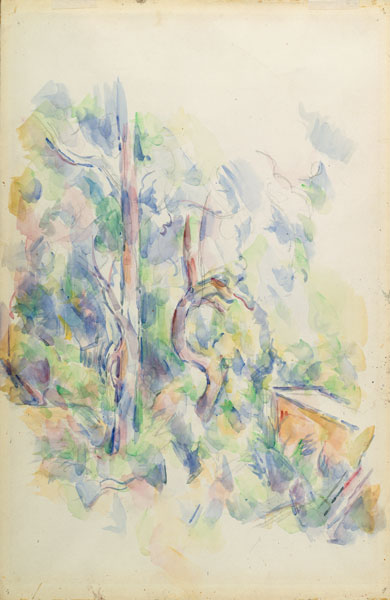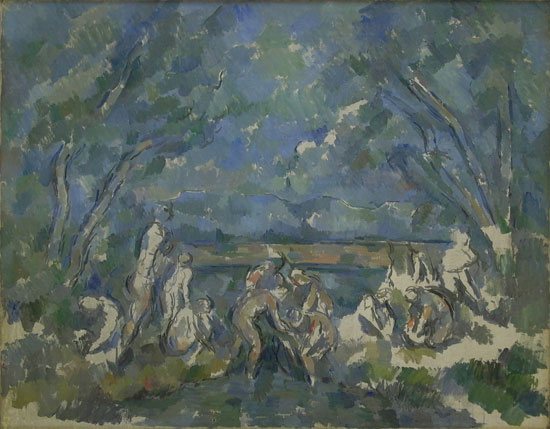Published by Editions CRÈS in English and French.
Read a brief description of the two-voume book.
The excerpts below are from Machotka's discussion on these Cézanne paintings:
Portrait du peintre Achille Emperaire | Arbre trodu et citerne dans le parc du Château Noir | Baigneuses | Nature morte
| This book can be purchased at local bookstores and museum bookshops in the U.S. and France. Check your local library as well.
It is available online from: |
 Volume 1, Fig 56; Volume 2, pgs. 57-58. |
Nothing in Cézanne's development prepares us -- as nothing in 19th century painting prepared Cézanne's contemporaries -- for the monumental and unique Portrait du peintre Achille Emperaire of c. 1868. In some details, such as the undulating outlines, its style recalls other works of the period, but in all the crucial matters -- the mercilessly flat, frontal conception and the self-consciously ungraceful surface -- Cézanne presents a vision that is peculiar to this painting and is never used again by him. There is perhaps no greater testimony to Cézanne's pictorial honesty than the choice of a heroic format for a figure with a large, noble head and withered legs, and no clearer example of the originality that is so apparent to us and was so disturbing to some of his contemporaries. The sitter is placed in the same chair as was Cézanne's father and the painting is on the same scale. But the figure is now seen more frontally and the space is kept shallow; the forms are barely modeled and there are few overlapping planes. Each form, no matter how small, is clearly outlined, as if it were a matter of the same literal honesty that dictated the pose. Emperaire had in fact a handsome head, as Cézanne records in two drawings and a small oil portrait, and could strike a self-assured pose, as we know from a photograph reproduced by Rewald. Cézanne could have painted him with his infirmity hidden or with his stature lengthened; seen from slightly below and one hand on his hip, Emperaire's proportions would go unnoticed. But that is neither in Cézanne's character nor in his nascent vision of painting. The portrait is no exercise of the kind of touch that calls attention to itself and proclaims virtuosity. On the contrary, there is a kind of renunciation of style that leaves us with only one thought: whatever its purpose, here is a new vision of painting. |
| Cézanne's achievements in watercolor, which seem to me of equal rank to those of his oils, are surely
apparent from the comparisons I have made with paintings where the subjects were the same. Cézanne made use not of the medium's precision of line, liquid washes,
or contrasts of light and dark, but of its transparency, its layering, and its white voids. Local color, light, denseness, depth -- all can be represented by color
patches set down in overlapping layers, while white voids invite us to fill them with surface or space. This makes his late watercolors masterpieces of paradox:
suggestive yet precise, tentative yet definite, independent in color and rhythm yet evocative of the order they describe.
We gain one kind of understanding of the watercolors when we look at the ones that are studies for oils, and another when we look at the ones that remained independent. Arbre tordu et citerne dans le parc du Château Noir seems like it had to remain independent; it is too satisfactory as such, concentrated as it is in the center, emphatically linear, suggesting a vaguely continued space beyond the right edge. A painting would have had to complete the top and bottom, integrate them with the composition, and contain the space on the right more clearly. Here, all is rhythm and suggestion; even the outlines are interrupted and taken up again, inhabiting the same tentative space as the color patches, yet describing their objects (cistern, tree, branch) as accurately as is needed. |
 Volume 1, Fig 349; Volume 2, pgs. 228-229 |
Baigneuses
| In this last decade, Cézanne painted only twelve baigneuses and seven baigneurs, but this should not be read as a waning of interest; on the contrary, three of the female groups are monumental. Several of the smaller baigneuses could be viewed as studies for the large ones because they portray one or another of its figures, but they might equally well be independent. |
 Volume 1, Fig 299; Volume 2, pg. 206 |
Whatever their intent or their sequence, there is one painting that dominates them. It is larger than the others and spacious, and contains enough figures to seem like a preparation for the great bathers -- but its composition is altogether original and its handling free, and as much as I would like to imagine it very large, I am convinced that it would lose most of its unforced spontaneity. Its figures are situated between two sets of trees, on the near side of a body of water, as in the Philadelphia great bathers, but here the center is filled rather than empty. Four central figures huddle cosely together in an intimate knot, with their round backs outlined in short, curved touches; they are nestled as if naturally within the trees that parallel their backs, and the nervous swirl of the concentric lines draws us inward and away from the sides and the opposite shore. The outer figures are only outlined, with bare canvas sometimes sufficing for their skin, and it is not what they might or might not be doing that interests us, but the sensuousness of the lines forming the bodies and the trees.
Cézanne's emotion is once again expressed in form: not only in the energetic touches or the effortless enfolding of the figures,
but in color. Here a curious reticence makes him paint the skin tones a neutral brown and create the kind of diffuse light one might expect in a forest clearing. It is hard,
however, not to see the bodies as pink; so alert is he to induced colors that he can rely on the dark blue-green surroundings to push the browns toward the more fleshy pinks.
The painting is masterly in its restraint, balanced in its colors, and alive with movement.
The straightforward effect of balance and wholeness in Nature morte at first obscures how subtly it was achieved.
The apparently white tablecloth, for example, is in fact composed of all the tones of the background, its folds painted with lighter shades of grey-green, grey-blue,
and ochre; the pitcher is dominated by a large dull flower, halfway between grey-green and grey-blue, instead of the dark pink one that appears in Pommes et oranges
and other late still lives. These ostensibly white objects, while remaining luminous, now become an integral part of the ground, having been brought together into a coherent
color space that is both rich and measured. Other flowers on the pitcher, normally red, are now brown, of a shade that joins them to the table, to the rug in the back, and
even to the bown patches on the walls. An effect of unity is important to most kinds of painting, but the degree of unity that Cézanne achieves here is extraordinary and forms
one of his most moving accomplishments. It is an effect that, in spite of its elaborate genesis, is given to the viewer at once, on the first viewing especially, forcing a
sharp intake of breath.
